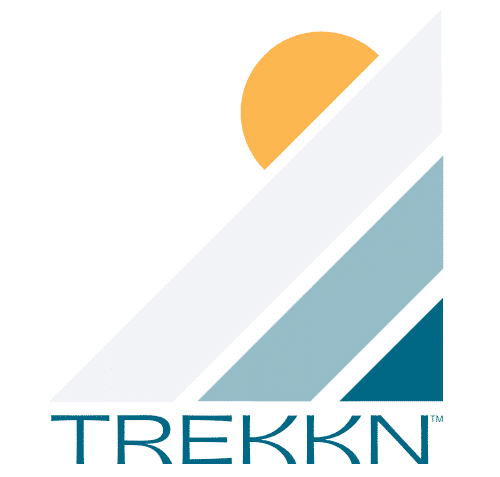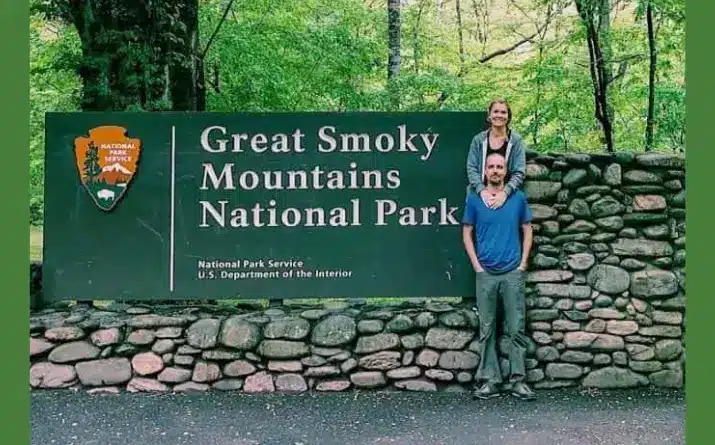Gear for Winter Adventures: Tips from an Expert
When winter weather sets in, embarking on a hike might seem daunting, but with the proper preparation it can be an awesome experience. Returning rosy-cheeked and pleasantly worn out after an escapade in the snow is one of my favorite feelings. In this article, I share the best gear for winter adventures that I use to keep myself warm and safe when hiking and exploring the great outdoors.

TREKKN is ready-supported. We earn a small commission for qualifying purchases, at no cost to you. Please read our disclosure.
Get a Grip
One of the key considerations in planning for a winter hike is the ground covering—if you’re trekking somewhere where snow or ice might be covering the trail, you want to ensure that your footwear is up to the task of keeping you moving forward safely.

Snowshoes
If you’re hiking in an area with more than a few inches of snow, you need a pair of snowshoes. Snowshoes help distribute your weight across the snow, preventing your legs from sinking into the snow and letting you maintain a solid clip across the terrain.
While I love the look of the old school tennis-racket-shaped show shoes, technology has come a long way since the 1900s. You can now find snow shoes that are lightweight and easy to maintain.
I recommend the MSR Lightning Trail snowshoes. They’re compact, easy to put on and adjust, and reliably keep you perched atop the snow.
Microspikes (Ice Cleats)
If you’re headed on a moderately-graded trail that may have intermittent snow or icy conditions, over-the-boot microspikes (also known as ice cleats), like YakTrax, will help you maintain a secure grip on the ground.
The great thing about this tool is that they can be added onto your existing boots, and kept in your daypack if you’re not sure exactly what conditions you’ll encounter on a particular trail.

Trekking Poles
Having a pair of trekking poles with snow baskets can also be an asset to your stability as you make your way across the snow.
Be sure to purchase the correct length based on your height. Available in 100cm - 130cm lengths.
- Aluminum shafts
- Z-pole design
- Speed-cone deployment
- Foam grip
- Breathable, moisture-wicking strap
Related Reading: Best Day Hike in Banff National Park for Panoramic Views
Insulated Hiking Boots
And, finally, in the footwear category, you want to cover your feel with boots that will keep your toes toasty and dry.
Since you’re adding traction with your snowshoes or spikes, you can opt for a boot that focuses on warmth over traction. My go-to for winter hiking are BOGS boots. The insulated rubber and neoprene sandwich my feet in warmth. There have been many hikes where my feet have been noticeably warmer than my hiking companions’ thanks to the boots.
Be a Layer Player
The core duality of winter hiking is the contrast between the cold air outside and the internal heat that you generate through motion. Therefore, layers are a winter hiker’s best friend. On the inside, insulating layers will help you trap the heat close to your body while wicking away moisture.
On the outside, a shell will repel exterior moisture and block wind. There are a number of effective natural and man-made materials for these roles. But cotton is not one of them. Avoid cotton at all costs!
Wick, Insulate, Protect
For my winter hikes, I think WIP: wicking, insulating, and protecting.
WICKING
For the layers closest to my skin, I prefer a thin merino wool long-sleeved top and pants. Wool is known for its ability to retain its insulating properties even when wet. Merino wool, spun from the wool of merino sheep, is prized for its relative softness and for not holding onto body odors.
INSULATING
Next, I want to trap the heat I’m generating through my activity near my body with a wool sweater or synthetic fleece layer, and a down jacket. To keep my core extra warm, I may also add a down vest into the mix.
PROTECTING
Finally, I put on a windproof and waterproof shell and pants to keep the elements swirling outside, not on, my body. My current top pick is the Patagonia Powder Town line because they’re insulating but breathable, have a ton of pockets, and venting zippers, as well, for once I’m on the move.
Related Reading: How to Layer Clothes for Outdoor Adventures
Protect Your Extremities
With the bulk of our body protected through our “WIP” layering, we don’t want to forget about covering up our extremities to get in on the warmth.
Cover Your Hands, Feet and Head
HANDS
I personally prefer mittens on trail—I feel like my fingers can contribute to warming each other by being in one area together. Other people might prefer the precision of using waterproof, insulated gloves.
Either way, look for an outer material that’s waterproof and breathable with an insulating inner layer.
FEET
Feet: Use wool or synthetic socks to keep your feet warm even if they get wet. I’ll say it again: no cotton!
NECK & HEAD
I love the combo of a fleece neck gaiter and a wool beanie for their versatility. I can pull the gaiter up or push it down to help regulate my temperature. But on really wind-whipping days, I might opt for a balaclava to leave as little of my skin exposed as possible.
EYES
With the extra glare coming off the snow, quality sunglasses are even more important to protect your eyes. If the snow is actively coming down, you may opt for googles for even more protection.
Stay Safe
Just as you would with any other day hike, you want to be prepared for emergency situations. This means packing a well-stocked first aid kit, headlamp, navigation tools, and water and food.
Equipped with the right gear, you can head onto the winter trails with confidence!
What is your favorite gear for winter hiking? Please leave a comment below and let other readers know what you recommend and your favorite hiking trails for winter adventures!
Related Reading


Jane Cullina is based in Santa Barbara, California, where she draws inspiration from the juxtaposition of sea and mountains that frame her surroundings. Her experiences as an outdoor educator on both coasts cemented Jane’s belief that time spent in nature leads to extraordinary moments of growth and connection. Today, whether at work as a project manager, educator, and writer, or at play in the wilderness of the U.S., Canada, and beyond, Jane seeks to weave together the practical with the profound.



















